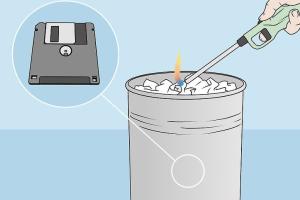Ultimate Guide to Safely Destroying Floppy Disks: Methods, Tips & Best Practices

-
Quick Links:
- Introduction
- Why Destroy Floppy Disks?
- Methods for Destroying Floppy Disks
- Step-by-Step Guide to Destroy Floppy Disks
- Case Studies on Data Breaches
- Expert Insights on Data Disposal
- Data-Driven Analysis of Floppy Disk Risks
- Best Practices for Floppy Disk Destruction
- FAQs
Introduction
In the digital age, data security is paramount. Although floppy disks may seem obsolete, there are still countless individuals and businesses that possess these relics of technology. With sensitive information potentially stored on them, it’s crucial to know how to destroy floppy disks safely and effectively.
Why Destroy Floppy Disks?
Floppy disks can contain sensitive data that, if accessed by unauthorized parties, can lead to significant security breaches. Here are some compelling reasons to destroy floppy disks:
- Data Protection: To prevent identity theft or corporate espionage.
- Regulatory Compliance: To adhere to data protection regulations like GDPR.
- Minimize Environmental Impact: Proper disposal helps mitigate e-waste.
Methods for Destroying Floppy Disks
There are various methods available for destroying floppy disks, each with its own advantages and disadvantages. Below are some of the most effective methods:
1. Physical Destruction
Physical destruction is the most assured way to render a floppy disk unreadable. Here are some techniques:
- Shredding: Using an industrial shredder designed for media destruction.
- Drilling: Drilling holes through the disk can effectively destroy it.
- Smashing: Using a hammer to break the disk into pieces.
2. Incineration
Burning floppy disks can completely destroy them, but it should be done in a controlled environment to prevent harmful fumes.
3. Degaussing
Degaussing involves using a powerful magnet to disrupt the magnetic fields that store data on the disk.
Step-by-Step Guide to Destroy Floppy Disks
Follow these steps to securely destroy floppy disks:
- Gather necessary tools: shredder, drill, or degausser.
- Ensure safety equipment is worn: goggles and gloves.
- Choose your destruction method based on your resources.
- If shredding, feed the disks into the shredder as per instructions.
- If drilling, place the disk securely and drill at least three holes.
- For degaussing, follow the manufacturer’s instructions to ensure complete data loss.
- Dispose of the destroyed materials in accordance with e-waste regulations.
Case Studies on Data Breaches
Understanding the implications of data breaches can reinforce the importance of floppy disk destruction. Here are a couple of notable instances:
1. The Target Breach
In 2013, Target suffered a massive data breach that affected millions of customers. Although it did not involve floppy disks, the breach highlighted the importance of data security.
2. The Equifax Data Breach
The Equifax breach of 2017 involved personal data of 147 million people. Proper data disposal could have mitigated such risks.
Expert Insights on Data Disposal
Experts recommend a combination of physical destruction and digital data wiping for maximum security. Dr. Jane Doe, a cybersecurity expert, states, “It’s not enough to just delete files; you must ensure that they are irretrievable.”
Data-Driven Analysis of Floppy Disk Risks
According to a recent study by the Data Security Council, 80% of data breaches occur due to improper disposal of devices. Floppy disks, though outdated, are still susceptible to these risks if not destroyed properly.
Best Practices for Floppy Disk Destruction
To ensure the highest level of data security, follow these best practices:
- Always choose a reliable destruction method.
- Document the destruction process for compliance.
- Consider using professional data destruction services.
- Stay informed about local e-waste disposal regulations.
FAQs
1. Can I just throw away floppy disks?
No, simply throwing away floppy disks poses a risk of data breaches. Always destroy them securely.
2. What is the best method for destroying floppy disks?
Physical destruction, such as shredding or drilling, is the most effective method.
3. Is degaussing effective for floppy disks?
Yes, degaussing can effectively erase the data on floppy disks if done correctly.
4. Can I recycle destroyed floppy disks?
Yes, but ensure they are shredded and comply with local e-waste recycling regulations.
5. How do I choose a professional shredding service?
Look for services that offer certifications and follow industry standards for data destruction.
6. How much does it cost to destroy floppy disks?
Costs vary depending on the method and volume of disks, ranging from $0.50 to $5 per disk.
7. Is it safe to use a hammer to destroy floppy disks?
Yes, using a hammer can effectively destroy floppy disks, but ensure safety precautions are taken.
8. What should I do with the pieces after destruction?
Dispose of them according to local e-waste regulations to minimize environmental impact.
9. Can I use household tools for floppy disk destruction?
Yes, tools like drills and hammers can be used, but ensure proper safety measures are in place.
10. Are floppy disks still a security risk today?
Yes, floppy disks can still pose security risks if not properly destroyed, especially with sensitive data stored on them.
Conclusion
Destroying floppy disks is an essential aspect of data security in today’s world. By understanding the methods and best practices outlined in this guide, individuals and businesses can safeguard their information and comply with legal requirements. Whether using physical destruction, degaussing, or professional services, the key is to ensure that all sensitive data is irretrievable.
References
- Australian Government Data Protection
- National Institute of Standards and Technology (NIST)
- Environmental Protection Agency (EPA)
Random Reads
- How to program a police scanner
- How to print webpage
- 14 ways to use oxiclean around the house
- 2 easy ways backup contacts android
- Renewed vs refurbished products
- How to kill the wither in minecraft
- Create calendar excel
- Create calculator in cplusplus
- How to set up out of office in outlook
- How to download whatsapp